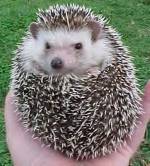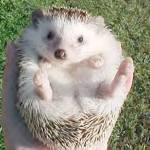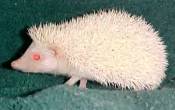| Go To : TWL Annex : PetHobbyist.com : ExoticHobbyist.com |
|
||||||||||||||||||||||||||||||||||||||||||||||||||||
Hedgehog Treats
by Becca Loane
email PHQuills
 Part
I - ADDING TREATS TO YOUR HEDGEHOG'S DIET
Part
I - ADDING TREATS TO YOUR HEDGEHOG'S DIET
Treats are a very good bonus to your hedgehogs diet. They serve two main
purposes. First, they add variety to the diet. A highly nutritious diet
is very important, but same old same old can get very boring. Adding variety
to the diet by way of treats can help increase hedgehogs' food consumption,
activity levels, and sociability. As well, it can be a nutritional benefit,
depending on the quality of the treats provided.
There is no set "right" treat for hedgehogs. There is rather, a set of guidelines that you can examine food choices by to determine whether they should play a part in the treat roster.
Is the food nutritious? While a little bit of "junk food" is ok, it is strongly preferred that you choose treats that will provide some nutritional benefit over nutritionally empty fillers.
Is it safe? Sticky, very hard, or stringy foods are not a good idea for a hedgehog food, due to the potential for them to get lodged in the mouth or choked on. Some famous no-nos in this department are raisins, peanuts and many other nuts, raw carrots, and other similar items.
Is it unhealthy? Highly fatty or sugary treats are not good ideas, as well as anything that is spiced. Salt is to be avoided as well. These foods can cause intestinal upset, and in too large quantities, can cause nutritional imbalances or severe health problems.
If a food option comes up well to these rules, then it is usually worth a try.
How to feed treats is something else that needs to be considered. Treats are NOT to be the majority of the diet. They should be offered in very small quantities, a few times per week. Daily is not necessary, in my opinion, and can be negative to the overall dietary needs of the hedgehog. One or two small pieces of a treat per serving is ideal, in my opinion. When you introduce a new treat, you should offer a very small amount for a few days before introducing any other new foods, to rule out any possible allergic reactions. This way, if there IS a negative reaction, you know exactly what caused it, and can make a note not to feed that food ever again.
Some commonly enjoyed human food treats to offer include cooked chicken, scrambled or boiled egg, other cooked meats, melons, strawberries, peaches, other soft fruits, peas, cooked carrots, green beans, cooked sweet potato, tomato, cottage cheese, yogurt, small pieces of cheese, baby foods, baby turkey sticks, and more. Non-human foods can include wet cat foods, cat treats, ferret treats, and of course, BUGS!
Be aware that your hedgehog may be picky about what treats he prefers,
so it may require trying small amounts of many different treats before
you will find the ones that really make your hedgehog lick their lips.
And what they don't like at one time can be offered again later, they
may change their mind.
 Part
II - INSECTS AS A PART OF HEDGEHOG DIETS
Part
II - INSECTS AS A PART OF HEDGEHOG DIETS
One of the most common treats for hedgehogs is various insects. Since
hedgehogs are insectivores, there is a lot of debate on whether insects
should actually be considered a treat, or if they should be a good portion
of the hedgehogs' diet. My personal opinion is that they should be used
as a treat. In the wild, hedgehogs do eat insects as a very large percentage
of their diet. However, in captivity, their activity levels and other
habits are very different than those of a wild hedgehog, and therefore,
an insect diet is not exactly suited to their nutritional needs.
One of the main things to remember about insects is that wild caught bugs are not a good idea for feeding hedgehogs. It is impossible to know what the insects that you catch outside have been exposed to. They could be carrying parasites, toxins, bacteria, or fecal material that they have tracked through or landed on. Even if you don't use pesticides or herbicides on your property, it is possible that your neighbors do, and therefore any use of wildcaught bugs could make your hedgehog susceptible to toxins from these materials, that can make your hedgehogs very ill. Therefore, you should ONLY feed farm-raised insects (or home raised) to your hedgehogs.
One of the most commonly fed insects are crickets. Adult crickets contain approximately 65% protein and 14% fat(1). This makes them a great protein source for a treat, with a relatively low percentage of fat. Typically, I feed 3-6 crickets per serving. How you feed these crickets also has a wide variety of choices. Crickets can be purchased live from many pet stores and online distributors. These can either be fed as is (which also provides stimulation to the hedgehog) or pre-killed. The easiest way to kill crickets is to put them into the freezer for a while. They are also available "freeze dried" from some online distributors and pet supply companies. These are pre-gut loaded to provide them with extra vitamins and minerals, and then packaged in small jars or cups. Packages are usually sold by weight, and be aware that with the moisture removed, a couple ounces of freeze dried crickets are actually a substantial number. Freeze drying provides these crickets with a long shelf life, and the convenience of not storing and feeding live crickets.
Closely tied with crickets for feeder popularity are mealworms. Mealworms are actually the larval state of the mealworm beetle, and all stages of life of these insects are suitable for feeding. Mealworm larvae (what you will receive when you order mealworms) contain approximately 53% protein and 33% fat. The beetles contain 64% protein and 18% fat. I recommend 3-4 mealworms or 4-5 beetles per serving. Live mealworms are also usually available in pet stores and most online insect distributors. If you have a little extra space in a warm area of your house, you can start your own mealworm colony. I use sterilite sweater bins with very small holes poked in the top half of the box. Then, I dump a box or two of oatmeal and a box of unprocessed wheat bran (both available in most grocery stores) into the bin, along with a "starter batch" of mealworms. 500 mealworms will provide a very active and self-sustaining colony for most small usage feeding situations. Periodically, perhaps 2-3 times per week, you can add things such as baby carrots, apple slices, or potato slices to the top of the bedding, removing any leftovers from previous materials. Placed in a warm area, these mealworms will eventually morph into pupae, which are white legless creatures that resemble alien movies that wiggle their tail section frantically when picked up. These pupae can also be fed, with 55% protein and 31% fat. After a period of time as pupae, they will shed into an adult beetle. These are approximately 1/2 in. black beetles, and according to my hedgehogs, are crunchy and delicious. I will take their word for it. These beetles are the sexually mature form of mealworms, and will breed and lay many eggs before dying. If you leave your colony alone for a couple of cycles through this process, you will have MANY mealworms that are ready to be fed. This colony is odorless, completely silent, and takes up very little space for the amount of product that it can produce for your hedgehogs. These mealworms are also available in some sources as a freeze-dried version, with hundreds and hundreds of worms packed into a small jar. Long storage life, and very convenient for the more squeamish hedgehog owners.
Less commonly used, but still suitable insect treats include wax worms. These are the larval stage of wax moths. These are more pricey than the previously stated insects, and are not as easily found, but if you find them, they contain approximately 42% protein and 46% fat. Definitely not a low fat treat, these should be fed in extreme moderation, perhaps 1-2 per serving. They also come in the roasted variety, packaged in a small jar. These smell alarmingly like peanut butter in my opinion, but when you open the jar, it is almost definite that it WILL catch your hedgehogs' attention.
Another of the less known feeder insects are silk worms. These are definitely harder to find than the crickets and mealworms, and the price shows this as well. From what I have read, these are best fed in a young stage, as the full grown silk worms are... um.. substantial. I was not able to find the nutritional content of these worms at this time.
Earthworms can be fed, but in my opinion, are one of the less desirable choices. A whole earthworm is almost guaranteed to give your hedgehog very foul smelling liquid poos, and cutting them into manageable portions is almost as icky as the poo that the hedgehog produces.
 Nutritional
information for various insects cited in this article was found at Nutrition
Advisory Group Handbook. [article in PDF format]
Nutritional
information for various insects cited in this article was found at Nutrition
Advisory Group Handbook. [article in PDF format]
Some supply sources for the insects listed in this article can be found on the commercial listing pages at: ExoticHobbyist.com and kingsnake.com.
Notes:
The information in this article has been adapted from and reprinted
with permission from Daisy Meadows
Exotics
|
 |
This page is maintained by The
Wyvern's Lair.
Contact the webmaster : E-MAIL. © 2004, The Wyvern's Lair |
Visitors since November 2004 |